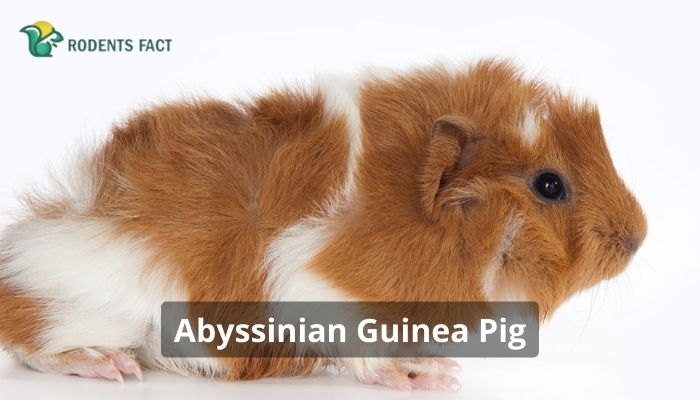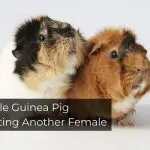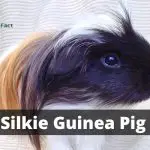Abyssinian Guinea Pig: Facts, Personality, Diet, Health Issues
Many people keep the abyssinian guinea pig as a pet. They are guinea pigs with natural rosettes and come in albino, agouti, dalmatian, and tortoiseshell hues.

One of the simplest ways to tell this breed apart at a glance is by its unusual hair. In contrast to other cavies, the Abyssinian has long, straight hair that grows to 1.5 inches. Rosettes of hair are also seen on their bodies in several locations. This is the epitome of a “bedhead” look!
Typically, an Abyssian has six to eight rosettes, although they may have up to ten in certain extreme situations. These stunning creatures are often used in guinea pig shows. Abyssinian guinea pigs are braver, quirkier, noisier, livelier, more playful, and more intense than other guinea pigs.
Abyssinian Guinea Pig Facts
Guinea pigs have a lot of fascinating stuff to share. These are the facts about the Abyssinian Guinea Pig-

| Length | 8 – 12 inches |
| Weight | 800 – 1400 grams |
| Lifespan | 5 – 7 years |
| Colors | Brown, black, albino, roan |
| Temperament | Calm, gentle, and easy to train |
| Best Suited For | Families with children, families with several pets |
There are not many other guinea pigs like it, hence the Abyssinian Guinea Pig is special. Their bodies are long, and their faces are small.
Rosettes generate an irregular spikey pattern in the fur, typically between three and four centimeters long. Each guinea pig has six to eight rosettes covering its body.
History of Abyssinian Guinea Pig
This kind of wild rodent, known as a cavy, originates from the domesticated variety.
The Andes Mountains in South America are the original home of Abyssinian guinea pigs; they are not native to either Guinea or Abyssinia.
In addition, they are not related to pigs; they are rodents, the same classification as rats and mice.
Also, guinea pigs are farmed for food in certain parts of South America, not as pets!

Guinea pigs of the Abyssinian strain are a very ancient breed.
These intrepid tiny animals were first seen in Victorian England, where they were kept as exotic pets because of their luxurious coats and adorable appearances. They had been brought back to the UK by adventurers.
Do you own a bird and are worried about its food? Know if your hamster food is safe for birds.
Abyssinian Guinea Pig Lifespan?
Abyssinian guinea pigs may live for5 to 6 years with proper care and nutrition. At the same time, the typical guinea pigs live for 5-8 years.
The lifespan of pet Abyssinian guinea pigs depends on several things, including heredity and dietary habits.

The behavior of Abyssinian Guinea Pigs

Having an Abyssinian guinea pig is a lovely bonding moment for parents and children; they are attractive and exciting, and they need just as much attention.
Abyssinians are happiest with guinea pig buddies, attentive owners, frequent outside time, activity (they are friendly with kids), and routine change.
Abyssinian Guinea Pig Personality
Abyssinians are cheekier than other guinea pigs, according to one lifelong admirer.
Guinea pigs are social animals who flourish in groups. Abyssinian guinea pigs also like human company.
Abyssinians are clever and friendly, enjoying the human connection and learning tricks. You may use goodies to teach your basic pet skills.
Children love guinea pigs like peas and carrots. Educating young children on guinea pig care and handling is vital before bringing one home
Caring for an Abyssinian Guinea Pig
An Abyssinian is a relatively low-maintenance pet. They need food, exercise, and shelter like regular guinea pigs.

Attention and Socialisation
If there are no buddies or petting owners, they may feel lonely and bored rapidly. Suppose their fundamental demands for care are not satisfied.
Give extra consideration to your Abyssinian and have others pet it. Let it play with another guinea pig.
Allow your guinea pig to spend time outdoors every day and provide it with more exciting foods to eat. Petting and giving engaging activities are better than guinea pig toys.
Dealing With the Heat
Abyssinians have longer fur. Thus summer heat might be an issue. Imagine summering in a fur coat.
It may be like that for them; therefore, on hot days, supply cooling dishes. You may also provide a bath and a fan.
Bathing
Most guinea pigs do not enjoy bathing, but if you boil the water to lukewarm, let it place its feet in the tub, and fill it to chest height, bath time will not be a fight.
Use unscented shampoo and soap. After a wash, cover your Abyssinian in a cloth and wipe down its fur dry. Put it in front of a fan in hot weather.
Abyssinians seldom require baths. They groom themselves and love natural hair oils and scents.
But if they smell excessive, it is best to bathe them to wipe off extra skin cell accumulation and encourage healthy skin and hair.
Brushing
Another good tip is to brush the Abyssinian’s fur. They adore this therapy, which takes hours.
Abyssinians develop knots as they mature and condense. Abyssinian grooming inhibits fungal. A clean Abyssinian will receive greater household attention.
Abyssinian Guinea Pig Diet

Abyssinian guinea pigs should consume 80% hay, 15% fresh veggies, 5% pellets, and treats.
The remainder is supplied with veggies and pellets. Fresh fruits may add flavor and minerals to their diet.
Hay
Hay is a guinea pig’s staple food. It offers fiber, calcium, phosphate, and protein.
There is a wide variety of hay available for guinea pigs, but only Timothy or Orchard hay meets their nutritional needs.
This hay offers enough fiber, calcium, and protein for guinea pigs.
It should not be a major portion of your pet’s diet. High calcium concentration may contribute to bladder stones in guinea pigs.
Some inexpensive brands provide hay at a lower cost by mixing it with alfalfa, etc.
Hay is your guinea pig’s main meal, so do not interfere with it unless you want an expensive vet bill.
Read More: American Guinea Pig: Facts, History, Personality, Care, Diet, and Health Issues
Fresh Vegetable
Guinea pigs should also eat vegetables. It gives guinea pigs a new flavor and much-needed Vitamin C and other minerals. Guinea pigs can not manufacture vitamin C; they must consume it.
Guinea pigs with scurvy lack vitamin C.

Your guinea pigs need a cup of veggies every day. You may fill half in two places.
Experts suggest eating 5-6 veggies every day. Mix vitamin C-rich and low- to medium-calcium veggies for guinea pigs.
Pellets
Pellets are 5% of the diet. Pellets are a staple food for particular guinea pigs.
Some picky eaters do not like red peppers & cilantro, which are abundant in vitamin C.
Guinea pigs may not acquire enough fiber, vitamins, and minerals without pellets. So, pellets are good for your guinea pig.
Make careful you provide just what is required. Most experts suggest 1/8-1/6 cups of pellets a day.
Consumption depends on diet and age. Refill the dish as needed. Your guinea pigs will not eat them all.
Refill it anytime you clean the cage or offer them vegetables. Overfilling the bowl will cause your guinea pigs to chuck pellets, urinate, or defecate on it.
Treats
Treats help spice up guinea pigs’ diet. Some owners use them as positive reinforcement for teaching their guinea pigs.
It is a good idea to use these services once or twice weekly. Your guinea pigs may consume fresh fruits or treats.
Not all commercial guinea pig snacks are safe. Others include banned components yet are healthful and harmless.
Along with retail delights, fresh fruits are fantastic. There are many vitamins and minerals in fruit. Therefore it is a good idea to include it in your daily diet.
However, most fruits contain natural sugar, which harms your guinea pig. Feed it once or twice a week.
Abyssinian Guinea Pig Health Issues
Abyssinian guinea pigs may have health difficulties. Here are some common health issues new guinea pig owners should know.

Pneumonia
Streptococcus and Bordetella cause pneumonia. Some guinea pigs contain these germs but never display symptoms. If the animal is stressed or debilitated, the germs activate and cause sickness.
The infection spreads swiftly to sick animal cagemates. Pneumonia symptoms include cloudy eye and nasal discharge, sneezing, and breathing problems. With veterinarian care and TLC, most guinea pigs will recover.
Diarrhea
Abyssinian guinea pigs have diarrhea often. Their digestive tract contains a precise balance of “good” bacteria for proper bowel function.
Incorrect nutrition or illness might disturb the “good” bacteria ratio, causing diarrhea and dehydration. Your pet may stop eating, be sad, and have a low fever. Consult a vet if your Abyssinian guinea pig has diarrhea. Never give your guinea pig human antibiotics or antidiarrheals.
Scurvy
Abyssinian guinea pigs have scurvy. Vitamin C helps skin, joints, and gums. It helps wounds heal. The absence of vitamin C may cause various health issues, such as poor coat condition, a loss of appetite, and diarrhea.
Guinea pigs can not produce vitamin C. Therefore supplement their food. The optimal daily vitamin C dose is between 10 and 50 milligrams. Include fresh fruits, greens, and vegetables in your pet’s diet, but also offer them good-quality guinea pig pellets with extra vitamin C.
Vitamin C is found in greens, cabbage, artichoke, kiwi, and oranges. After 90 days, pellets must be discarded. The vitamin content degrades quickly after this period.

Tumors
Abyssinian guinea pigs may develop cancers on the skin and mammary glands. Your vet can surgically remove most benign tumors.
Abscesses
Abscesses are pus-filled infections. Guinea pig lymphatic system, teeth, cheeks, and skin may develop abscesses. Abyssinian guinea pig abscesses need veterinarian care.
Most abscesses may be treated medically, although surgery may be needed depending on depth and location.
Urinary conditions
All guinea pigs have urinary issues. Male guinea pigs may have bladder or kidney stones. Calculi may create life-threatening ureter or urethra obstructions.
When severely blocked, the animal can not urinate. Female guinea pigs get painful cystitis episodes. Blood in the urine, low appetite, straining to pee, and stooped posture are signs of urinary issues in both sexes.
Your vet prescribes medication for UTIs. Animals with stones need surgery and supportive care.
Skin Diseases
Young guinea pigs may have ringworm. Overcrowding, inadequate food, a filthy cage, or stress cause ringworm outbreaks.
The hair surrounding the afflicted area may fall out, and crusty, oozing scabs will form. Ringworm affects guinea pigs’ cheeks, ears, and skulls.
Your vet may prescribe topical or oral antifungals to cure ringworm.
Fleas, mites, and lice may infect Abyssinian guinea pigs.
Fleas may be observed crawling on an animal’s skin or hair. Check for flea filth using a flea comb.
Mites emerge as adults or nits (eggs) along the guinea pig’s hair shafts, generally on the face, shoulders, or behind the ears.
When guinea pigs have mites, lice typically follow. Direct touch or sharing their bedding might spread them.
You will notice your pet scratching and rubbing against the hutch’s furniture constantly if your pet is infected with skin parasites. In extreme circumstances, skin injury might cause infection. Your vet can cure these three parasites.

Barbering
Abyssinian guinea pigs are often barber. The animal nibbles its fur, causing “brush cuts”
Barbering is frequently caused by boredom; provide your pet with additional stimulation. Instead of DIY haircuts, give your guinea pig hay or chew toys.
Bumblefoot
Guinea pigs often get bumblefoot. The animal’s toe becomes infected, causing discomfort and lameness.
Bumblefoot is caused by unclean cage floors or poor animal husbandry. Bumblefoot is more common in overweight guinea pigs.
Frequently Asked Questions
1. Is Abyssinian Guinea Pig Rare?
Abyssian guinea pigs are common. They are guinea pigs with natural rosettes and come in albino, agouti, dalmatian, and tortoiseshell colors.
2. Are Abyssinian Guinea Pigs Friendly?
Abyssinians are wonderful first-time guinea pig companions for families with kids. Abyssinian Guinea Pigs are friendly, extroverted, and love attention. They may become friendly and affectionate pets with care and training.
3. What Is the Average Lifespan of an Abyssinian Guinea Pig?
External variables, genetics, and breed all have an impact. Himalayan, Peruvian, and Silkie guinea pigs may live from 5 and 8 years, whereas an Abyssinian can survive five to seven.
Final Words
Before deciding to get a new pet, it is essential to learn about the different breeds and their characteristics and demands. ” During your quest for a new pet, you may immediately prepare for the guinea pig’s arrival!
Children and adults alike having an abyssinian guinea pig as a pet, and the pig’s distinctive appearance draws the attention of all who see it. Pets like rabbits and ferrets are easy to care for and are an excellent way to bring your kids into the world of pet ownership.




